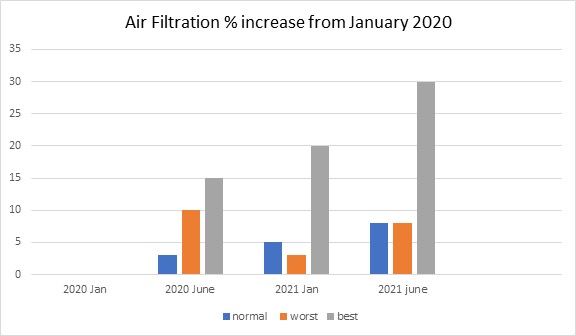
Coronavirus Technology Solutions
April 2, 2020
Coronavirus Impact on the
Filtration Market - Large or
Small?
The filtration market is being
transformed by the COVID-19
virus. Suppliers need answers to
the following.
·
Magnitude of the impact in the
short term
·
Magnitude of the impact in the
long term
The answers depend on the
following factors
·
To what extent is the virus
transmitted through the air?
·
Will the virus keep reoccurring?
·
Will COVID-19 devastation result
in permanent upgrades in health
expenditures for flu, HAI and
other major infectious diseases?
·
How can masks and air filters
best be used to meet the new
goals?
The market impacts can be
categorized from least to most
important.
The range of impacts for
surgical and N95 masks is
·
Least - surge in mask use for
the next six weeks and then an
oversupply from China makes for
a very weak long term market
·
Most - the world and individual
environment is segmented based
on safe zones ranging from
unsafe to very safe. Time spent
in any unsafe or less safe zone
would be with a mask.
The following chart shows worst
and best case scenarios. The
normal scenario would have been
for a small percent increase in
sales in 2020 over 2019.

In the worst and best case
scenario sales skyrocketed in
the first quarter of 2020 with
China increasing production to
200 million masks per day.
N95 masks increased from 200,000
to 1.2 million. In the worst
case scenario the sales decline
rapidly in the third quarter
2020 and fall to normal levels
in 2021. This causes major
supplier problems because of
overcapacity.
In the best case scenario many
of the world’s 8 billion people
are routinely wearing masks in
unsafe and semi safe areas.
Even if masks are reused 20
times this is 400 million masks
purchased each day.
One variable is the efficiency
of masks selected. You
have the lower quality, the N95
and even the N100 for better
virus capture. Another variable
is single use vs reusable.
A $15 reusable mask with 20
reuses would generate the same
revenues as a 75 cent disposable
mask.
The range of impacts for HVAC
filters and room purifiers is
·
Least - sales are higher for the
next few months but then revert
back to the level which would
have been achieved without the
coronavirus
·
Most - the recognition of
viruses and other infectious
diseases spurs a permanent
increase in the healthcare,
commercial and residential
markets of 30 percent or more.
There would be safe zones which
are protected by local
filtration systems. There would
be a need to create safe zones
on a temporary basis. This could
lead to a big rental market. The
number of air changes per hour
in many buildings could be
increased along with the
installation of HEPA filters.

The normal growth for air
filtration in healthcare,
commercial and residential would
have been about 5 percent per
year. In the worst case
scenario sales are up 10 percent
by June of this year. They drop
to just 3 percent above the
January 2020 level at the
beginning of 2021 and are back
to pre-corona growth levels by
June 2021.
With the best case scenario
sales are up 15 percent from the
January level by June 30. They
rise to 20 percent above 2020 by
the beginning of 2021. By June
2021 they are 30 percent higher
than in January 2020.
The spread for HEPA filters is
more than 100 percent in the
sales forecast. For room air
purifiers with HEPA filters the
spread is more than 200 percent.
The rental market could develop
from 0 to hundreds of millions
of dollars worldwide.
